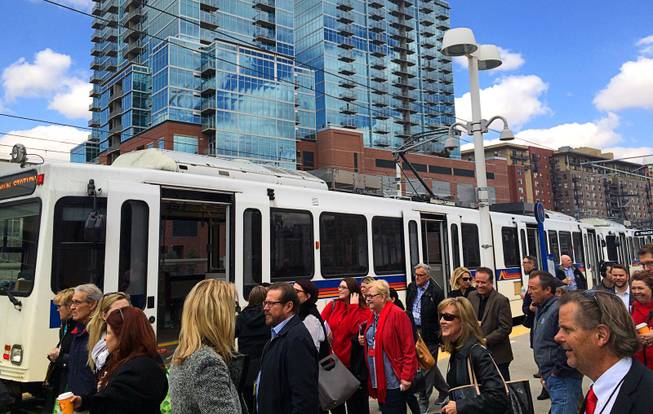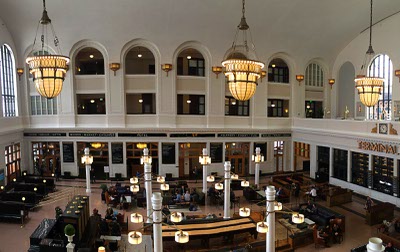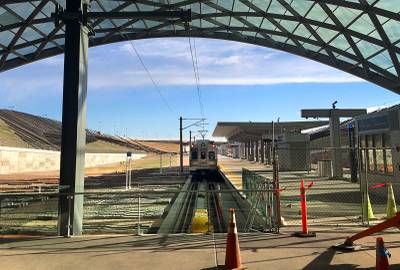
A view of travelers at the W light rail line at Union Station on Tuesday, March 8, 2016, in Denver.
Friday, March 11, 2016 | 2 a.m.
Related Content
When it comes to transportation development, Las Vegas and Denver have traveled down two very different tracks in recent decades.
That much was evident this week as about 50 Las Vegas leaders from the public and private sectors toured Denver and heard about some of its ambitious transit projects.
The trip, led by the Regional Transportation Commission and the law firm Brownstein Hyatt Farber Schreck LLP, was intended to be an in-person case study for the Las Vegas group. A wide-ranging plan recently released by the commission proposed many major improvements to Southern Nevada’s transit infrastructure — including, potentially, a light rail system.
Denver offered a close example of how such a system could be developed: The city has had light rail for more than 20 years, and its mass transit continues to grow in a very big way.
Also, Denver, like Las Vegas, is a pretty car-friendly area. But it has a much deeper history of robust mass transit. As Denver City Councilman Kevin Flynn told the Las Vegas group in a panel on Tuesday morning, the cities don’t have a tremendous amount of parallels in that area.
“A lot of where you’re going depends on where you’ve been, and I don’t think Las Vegas has been in exactly the same position Denver has,” Flynn said.
According to Flynn, Denver’s public transit history can be traced all the way back to horse-drawn streetcars in the late 19th century, a system that was followed by a network of cable cars and then electric trolleys. Those were eventually replaced with buses, and light rail entered the picture in the 1990s.
Since Denver’s original 5.3 miles of light rail debuted in 1994, the city has seen dramatic economic changes as the transit system has continued to expand — a point reiterated to the Las Vegas group this week. Denver is still building out the transit ushered in by FasTracks, a program approved by voters in 2004 that’s bringing 122 miles of new light rail and commuter rail to the area, along with other transit-related improvements.
The Las Vegas group that traveled to Denver included state legislators, local government officials and prominent businesspeople. As they explored the Colorado city, they not only heard about its extensive transit history, but also experienced it firsthand.
They walked through Union Station, an historic transit building that has been transformed into a multimodal hub complete with an underground bus station, a commuter rail stop that will soon run trains to the airport and easy access to light rail. The station also features 112 stylish hotel rooms and various options for shopping, dining and drinking. Its vast Great Hall is referred to as “Denver’s living room.”
“I remember when Union Station was just a decrepit shadow of what you see today,” said Brian Wild, policy director at the Brownstein firm and a Colorado native, during a Tuesday panel. He said the once-avoided area has now become part of “the lifeblood” of Denver.
The Las Vegas group also rode light rail and saw the new commuter rail station at Denver International Airport that will start delivering travelers from downtown via a new 23-mile line starting late next month.
One of the group’s last stops was a hard-hat tour of the under-construction site of a future facility for Panasonic Enterprise Solutions, which will be part of a 400-acre development near the airport. An executive from Panasonic indicated that his company would not have built there were it not for the fact that the new commuter rail line was nearby.
Compare all of that to the state of transportation in Southern Nevada and it becomes a bit of an apples-to-oranges analysis.
The Las Vegas area’s bus system is, by many accounts, thriving. Experts have said public transit on the Strip generates a farebox recovery rate of more than 160 percent, meaning revenue from passenger fares well exceeds the cost of operations there.
But Las Vegas has no real experience with the kind of mass transit present in Denver. On the light rail front, Southern Nevada isn’t even at the point where Denver was in 1994.
The most comparable transit form would be, of course, the Las Vegas Monorail. But that’s a different kind of system than light rail or commuter rail, and the transportation commission’s plan from last year specifically discusses light rail running from the airport down the Strip and into downtown Las Vegas. Light rail is also being considered for Maryland Parkway. The monorail, meanwhile, is looking at expanding over to Mandalay Bay and adding a stop for the Sands Expo Center.
Light rail efforts in Las Vegas also must contend with a unique leadership situation. Namely, Southern Nevada has a particularly distributed local government power structure, with the area’s economic engine, the Strip, largely outside the boundaries of its largest city, Las Vegas. And the dominance of the Strip in general makes buy-in from the private sector even more critical.
RTC General Manager Tina Quigley suggested at the conclusion of the trip on Tuesday that while it took Denver years to get to the point it is at today, Las Vegas has to start somewhere.
“Thirty years ago, (Denver) had leadership much like the group we had here today that said ‘we get it, collaboration is the way that we salvage Denver,” Quigley said. “That appeared, to me, to be a constant theme throughout this conversation.”



Join the Discussion:
Check this out for a full explanation of our conversion to the LiveFyre commenting system and instructions on how to sign up for an account.
Full comments policy